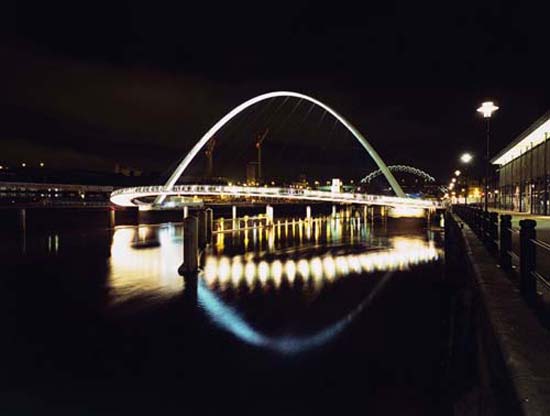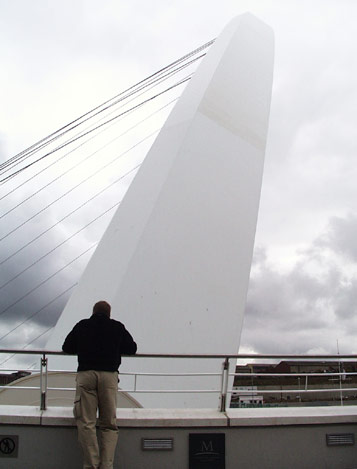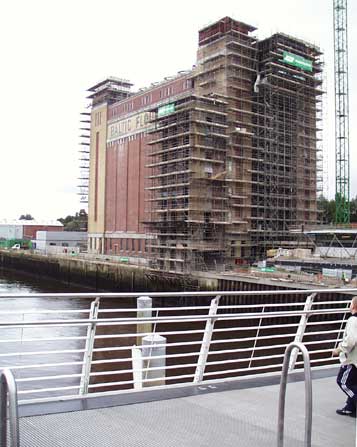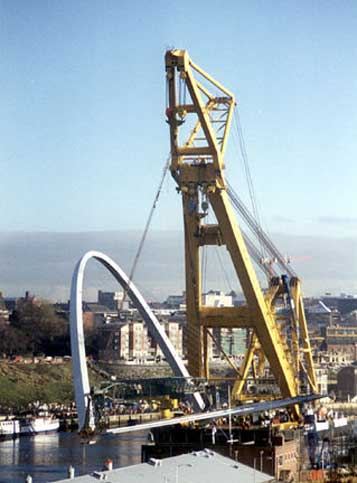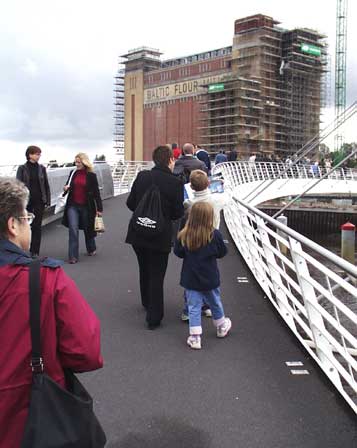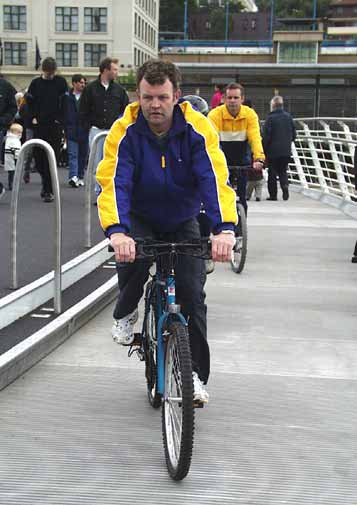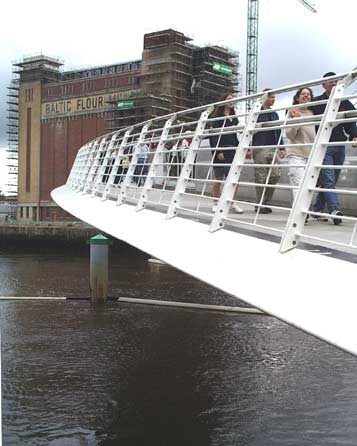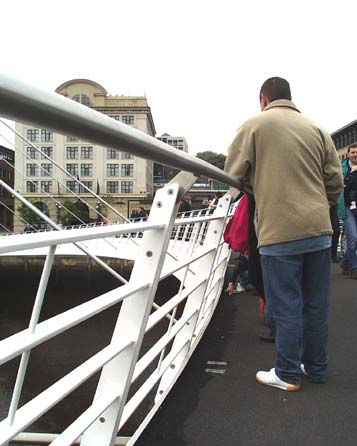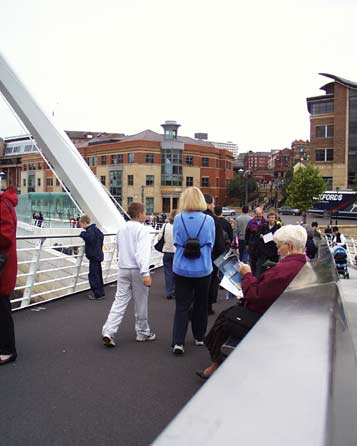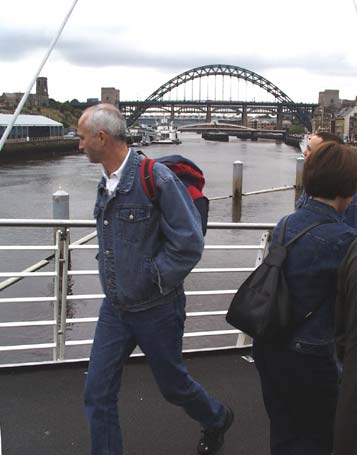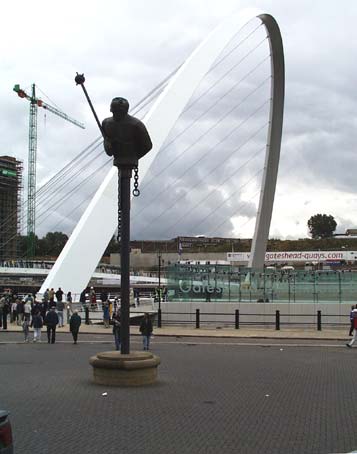|
Eyeblink over Tyne
Sat. 22nd Sept., 2001
|
|
A cool northern wind, a brooding low pressure and the threat of showers did not deter visitors to the newly
opened Gateshead Millennium Bridge. This most recent Tyne crossing links Newcastle's Quayside at Sandgate with the site of the Baltic Centre for Contemporary Art on the Gateshead side.
In 1996 Gateshead MBC entered the race for Millennium Commission funding that would grant 50% of the cost of a landmark project. The disused
and crumbling Gateshead Quay seemed ripe for renewal and in 1998 the Commission awarded its approval. |
 |
|
|
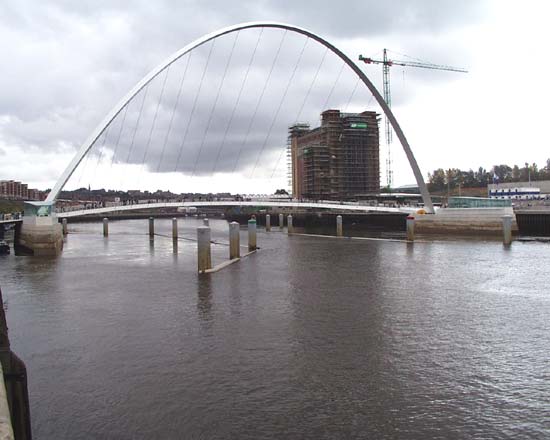 |
|
In addition to the ambitious plans for the arts centre and concert arena based around the derelict Baltic flour
mill, built in 1950, the engineers and architects wanted a link between the two communities on the Tyne. Certain constraints were imposed on the design:
- 30 metre wide navigation channel to be maintained - equal to Swing Bridge;
- 25 metre headroom when open - equal to deck on Tyne Bridge;
- 4.7 metre clearance when closed - equal to closed Swing Bridge;
- No permanent support to be built on Newcastle Quayside;
- Slope of walkway to allow pedestrians, cyclists and pushchairs easy access;
- Motor vehicles to be forbidden
The winning design was by a collaboration between Wilkinson Eyre and Gifford & Partners, and the main land
contractor was Harbour and General Works Ltd. of Gateshead. The arch and deck were fabricated by Watson Steel from Bolton, and the tilt mechanism was made in Sheffield.
Assembly took place in the AMEC
Wallsend shipyard and on the 20th November, 2000 a massive floating crane from the Netherlands, "Asian Hercules II", lifted the structure, floated it upstream, and placed it on the supports that had been
prepared inside coffer dams during the previous year.
The structure is two arches connected by suspension cables, meeting at two pivot points. Its electrically driven hydraulics tilt the whole to
allow navigation, at a cost of £4 per tilt; possibly the cheapest in the world. |
|
|
|
|
 |
After further construction work and tilt testing, the first full swivelling being on 28th June, 2001, it was
finally opened on schedule on Monday 17th September. During this first week, noted by Rosh Hashanah and the Autumnal Equinox, the walkway has thronged with visitors eager to experience the exhilaration of
this newest and most human of Tyne crossings.
Pedestrians have a non-slip gentle curve, here on the right, and cyclists have an unique PTFE striped surface on the left. This material offers grip both
dry and wet, and rapidly drains of water in even the fiercest of storms.
Stout bollards in the river are set to prevent shipping from hitting the supports. |
|
 |
|
The construction and opening of this bridge has been watched with interest by the cycle lobby in the area.
Tynebikes maintains a Web site outlining cycle routes in the area and other activities in the region.
If you have ever
tried to use other Tyne crossings by cycle you will view this new bridge with great relief. No steep banks, and no smelly and murderous cars and lorries to avoid. Add to this a wonderful view along the river
and its banks, and you have an unrivalled cycle experience.
Until recently I held the opinion that this new crossing was a waste of money, but since seeing it take shape and now having experienced it
first hand I have been completely won over. A Newcastle person's natural reluctance to see that anything worthwhile can come from Gateshead has to be suppressed.
The bridge span weighs 850 tonnes (837
tons), has a span of 126 metres (413.4 feet), and at rest the main arch rises 50 metres (164 feet) above river level. It cost a total of £22 million ($30.7 million)
The liberal UK newspaper, "The
Guardian" saluted this as;
"The World's first tilting bridge opened to shipping in the heart of a British region long
famous for innovation, the north-east. The bridge links Newcastle and Gateshead, two towns (sic) which have for so long glowered at each other with unease and suspicion across the Tyne, but that are now
growing together as bright and thriving as at any other time in their history." |
|
|
|
|
 |
 |
|
In 2001 "Surveyor" magazine voted John Johnson, Gateshead Council's Director of Design and Construction, its
Engineer of the Year for his vision. A similar tilting bridge is currently under construction to much acclaim in the USA. James Dyson, innovative inventor and engineer, said, "When purity is put into play,
as it is here, the result is extraordinary. I love the way you can see exactly how it holds itself up."
During construction and after, we have been able to view work in progress on the
Gateshead Council's Web site and cyber-Geordies
and others can now view the scene in real time by the Web cameras located on the Tyne Bridge. North Camera South Camera |
|
 |
|
Entering Newcastle from the Gateshead side the new Sandgate development faces the visitor. The gap between those
modern buildings is the site of Pandon Burn as it joined the Tyne. Before the 18th century when this was covered over, it was a pastoral retreat and before that the site of the first shipbuilding in
Newcastle. It formed a natural eastern boundary to the mediĉval town and was in the eastern parish of Sandgate.
Straight ahead is Sandgate House, and the to the right is the edge of Quayside House.
This relatively new development replaces a long line of goods sheds crossed by many rail lines and crane tracks. Since the demise of shipping here this area has undergone a renaissance. |
|
|
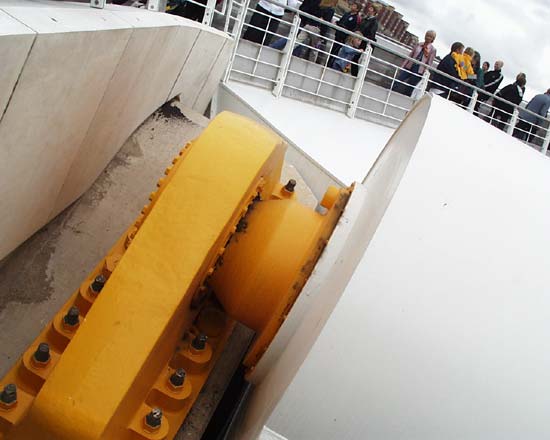 |
 |
|
The western upstream view from the new bridge gives an unrivalled vista of Newcastle's earlier design and
engineering innovation, the Tyne Bridge, opened in 1928.
Some people still cling to the erroneous belief that this was the trial version of the much larger Sydney Harbour Bridge in Australia.
The two bridges were built to similar designs using the same construction method of large land based cranes providing cantilevers for the two sides until they met in the middle. Although both bridges started
in 1925, the Australian version was not completed until 1932, over three years after the Tyne Bridge was opened. |
|
|
|
|
 |
Looking towards Gateshead from Anchor Chare, the site for the new concert hall is marked by that bold advertisement
for the Gateshead Quays Web site.
The Music Centre, due to be completed in 2003, takes the form of three giant bulbous inner tube curves standing against each other. The whole will take
on the look of a huge dirigible airship that has flopped onto the hillside beside the river. Its architect is Norman Foster, renowned for his vision and innovation.
This exciting development does not
have to sit alongside existing architecture, so a bold statement can set the tone for the future in this locality. It will be linked to the Baltic Centre by the Baltic Quays Leisure Complex |
|
 |
 |
|
Site and contents (unless otherwise stated) ©200-2 Tim. Pickford-Jones and Timmonet, Newcastle upon Tyne, United Kingdom.
|
|
|



